Framing the NEW New Boston and Donnels Creek RR, Part. 4
If you've been following along with our planning, groundbreaking, and framing articles, you know that we moved in November, 2016 and have been planning and working on the new iteration of our railroad since March, 2017. The new version will be entirely raised, some of it quite high for vertical interest. All of it will be set on lumber, not on dirt, to avoid the problems of burrowing animals and constant weeding we experienced with our first railroad.
This is, obviously a followup to our "Framing the NEW New Boston and Donnels Creek RR, Part. 3" article, in which I framed out what will be the top layer of a three-tier railroad and made plans regarding the waterfall and decking.
Once again, the "hard part," for me at least, was getting the frame level, after which things like decking may require a lot of physical effort, but are more-or-less mechanical.
Where Things Stood
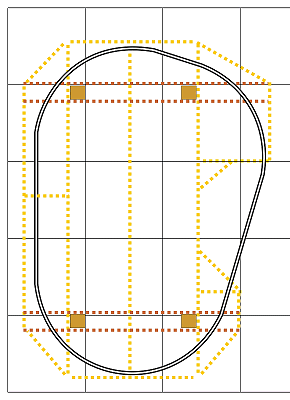 The graphic to the right shows the framing completed and ready for decking. I know, that it wouldn't have taken most people months to get to this point, but I am trying something entirely new for me, and I didn't want to accidentally create problems that would cause maintenance issues or some such later. The graphic to the right shows the framing completed and ready for decking. I know, that it wouldn't have taken most people months to get to this point, but I am trying something entirely new for me, and I didn't want to accidentally create problems that would cause maintenance issues or some such later.
Plus, as each piece of the puzzle fit together, I couldn't help seeing some way I could tweak things to make them a little better. In the software development industry, this is called "creeping enhancement," and is to be avoided - if you keep "improving" the design of software before the first release, you never get it out the door. In this case though, I was building something that I intend to be permanent, and I had no desire to implement a design that wasn't effective.
One change I made when I was contemplating this layer's design was to go from 4'-diameter track curves to 5'-diameter curves. I realized that the change might affect the clearance issue going around the posts, but my backup plan was to include a little extra "lip" on the decking if that was going to be a problem. In addition, no matter how carefully I measured, there was always a possibility that the "bridge" would cross the gap by the waterfall at a different angle than I expected. For this iteration, the "bridge" will simply be a 2"x6" board, but it needed to be installed in the right place.
So my plan was to get the decking to the point where I could lay out the track and verify those dimensions in a "hands-on" way.
You may also recall that I investigated decking material that would be cheaper than the 2"x6" ground-rated pressure-treated boards I eventually decided on, and realized that going with anything cheaper would have been too risky for something I hope to be maintenance-free, and far more permanent than my previous railroad.
 Other Materials Other Materials
In the meantime, the vinyl sheeting I ordered came and was better than expected. I expected a sheet of used billboard material with the printing on one side and black on the other. In my case, I got a sheet on which the printer had misfired, so it was never used. VERY nice. In addition, the vinyl sandwiches a fabric weave that will definitely add to the sturdiness of the material.
I also ordered two new packages of rail joiners and rail joiner screws and rail joiner screws . The used Aristo track I planned to use was in okay condition, but I wanted to be sure the connections were sound. By the way, . The used Aristo track I planned to use was in okay condition, but I wanted to be sure the connections were sound. By the way, 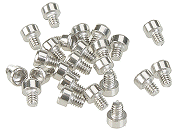  whenever you're installing track that has screw-in rail joiners, go ahead and order an extra set of screws ahead of time. The Aristo screws used to come with a little Allen wrench, and the Bachmann screws don't, but I have Allen wrenches on-hand from past projects. whenever you're installing track that has screw-in rail joiners, go ahead and order an extra set of screws ahead of time. The Aristo screws used to come with a little Allen wrench, and the Bachmann screws don't, but I have Allen wrenches on-hand from past projects.
And don't imagine you'll get your entire track plan built without losing any of those little monsters. BTW, I like screw-in rail joiners because they tend to keep a better electrical and physical connection longer than slide-on rail joiners.
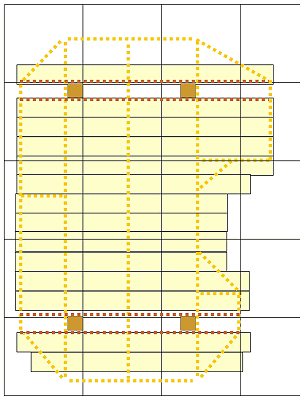 Planning the Decking Planning the Decking
As you may recall from the last installment, I had used my graphics software to estimate how many boards of each length I would be needing for the decking. The boards would run perpendicular to the supporting boards, of course.
That said, I still wasn't entirely sure how the gap for the waterfall would need to be shaped to accommodate the "weir" that would start the waterfall or the bridge that would cross in front of it. Rather than spending a lot of time trying to make the best possible guess, and still probably getting it wrong, I decided to leave the boards that would be on the edge of the waterfall a little long and cut them back later, when I was certain of things. I fastened those boards down by two screws only, so they'd stay in place, but I could remove them if I needed to do any real fine-tuning.
Running the Decking
This part was mostly just like running the deck for any other decking project. I separated the boards by 3/8" to allow plenty of room for drainage (I'll also be cutting slits in the vinyl underlayment as well.)
I did cheat when it came to working around the posts. Instead of doing a fancy cutting job like I'd do if it was on a patio deck, I just cut short pieces and filled in the gaps. There are bigger gaps than you'd usually see on a finished deck, but it's going to be covered with a lot of vinyl and dirt and stuff like that soon anyway.
The photo below was taken from a step ladder - the platform is about 5' off the ground, and the top of the top frame is about 6' off the ground, if that helps you visualize it better.
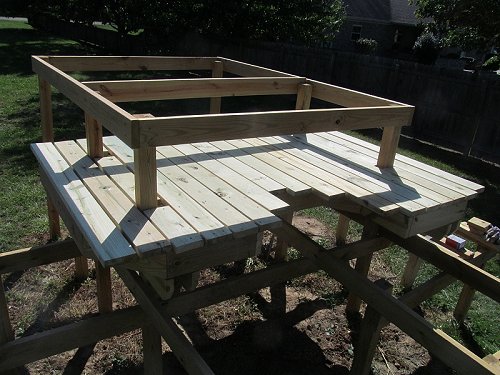
Note About This Article Title: You may be thinking that decking is not part of "framing," per se. You'd be right. But based on my experience just framing out the top layer, I realized that it would be a lot easier to do that stuff before I finished framing out the next layer down. So once I get the main stuff done on the top layer, I'll get back to framing the next layer down.
 The drawing to the right shows the status of the top and middle layer of the planned railroad as of Sept. 17, 2017. (I left the decking off the picture to avoid making it even more confusing.) The amber lines represent the top layer. The reddish brown lines represent the cross-pieces supporting it. The brown lines show the joists and supports that are installed are so far for the middle layer. The gray lines are the support pieces for the middle layer that have yet to be installed. I left them out while I was working in the top layer, because I needed the access. The drawing to the right shows the status of the top and middle layer of the planned railroad as of Sept. 17, 2017. (I left the decking off the picture to avoid making it even more confusing.) The amber lines represent the top layer. The reddish brown lines represent the cross-pieces supporting it. The brown lines show the joists and supports that are installed are so far for the middle layer. The gray lines are the support pieces for the middle layer that have yet to be installed. I left them out while I was working in the top layer, because I needed the access.
Still undefined on the middle layer is exactly where the middle layer's bridge will cross in front of that layer's waterfall. I will need to tweak the track plan a little once the top layer is finished.
Rail Joiners Revisited
The days are getting shorter so I'm having far less time to work outside in the evenings than I did just a few weeks ago. So one evening when I got a late start, I figured I'd put the new rail joiners on the old track. Turns out that the Bachmann rail joiners slide just fine on the old AristoCraft track, but the little holes for the screws don't quite line up. So after arguing with a few pieces, I dug out an old ice pick that I'm using to ream out the holes a little before I slide the rail joiners on the track.
If you do this, make certain you don't let your kids play with the ice pick while you're distracted with other things.
I'm also glad I decided to do this over a floor instead of over a lawn or dirt - I must have dropped screws a dozen times trying to get them installed in holes that wouldn't quite line up. Once I'm sure of my track plan, I will probably put several subassemblies together on the concrete patio before I install the track on the railroad - that way I'll only have a few screws to put in when I actually do the installation.
Testing ROW Placement
I did not fasten the two end pieces of decking down, because I wanted to be sure I wouldn't need to make some adjustment for the 5'-diameter track.
I had originally planned to use 4'-diameter curves and run only short pieces on that track. As the photo below shows, that would have worked just fine if I'd stuck to the plan.
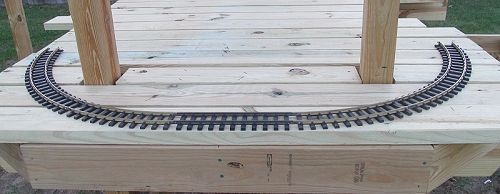
But then I decided that 5' diameter curves would be better, even if I just ran the shorty pieces I had meant to run up there. (Trains look better and run better on wider curves.) Obviously, I'd need to add a little extra to the east and west ends of the platform to allow enough clearance to run 8-wheeled cars on that level. That would be easy, since the framework was so solid, and I'm not planning to stand on the outside edges of the platform.
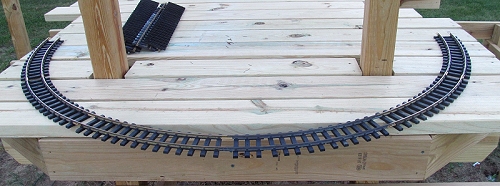
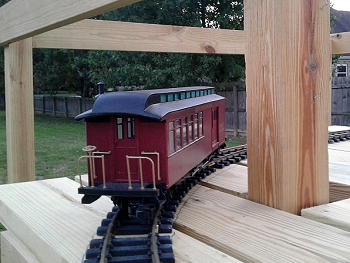 In rethinking this for the umpteenth time, I was trying to decide what the longest piece I was likely to ever run on that ROW would be. Again, I still plan to run shorties there for the most part (four-wheeled cars, 0-4-0s, streetcars, Eggliners, etc.). But I decided that by designing that ROW with enough clearance to handle Bachmann's passenger coaches, I'd be safe for anything else I'd be likely to put there. I tried a few other cars just to be on the safe side, including a long LGB woody. In rethinking this for the umpteenth time, I was trying to decide what the longest piece I was likely to ever run on that ROW would be. Again, I still plan to run shorties there for the most part (four-wheeled cars, 0-4-0s, streetcars, Eggliners, etc.). But I decided that by designing that ROW with enough clearance to handle Bachmann's passenger coaches, I'd be safe for anything else I'd be likely to put there. I tried a few other cars just to be on the safe side, including a long LGB woody.
If you were building this design as a freestanding table, you wouldn't need to worry about clearing the posts, because you'd be cutting the posts off below the decking level anyway. But by having the posts run up through that level, I had to take them into account.
Afterwards, I put the rest of the oval together. The long straight parts are two 2' pieces.
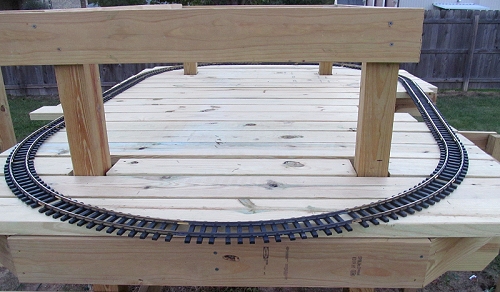
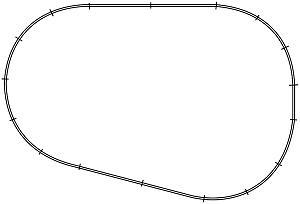 You can't see it in this photo, but at the far end, there's a 1' piece that spreads that end out just a little bit. That would be "wrong" according to any track planning resource in existence, but in truth, there's enough flex built into a railroad this size that you can add that anomaly without straining anything or hurting any of your connections. You can't see it in this photo, but at the far end, there's a 1' piece that spreads that end out just a little bit. That would be "wrong" according to any track planning resource in existence, but in truth, there's enough flex built into a railroad this size that you can add that anomaly without straining anything or hurting any of your connections.
In fact, most Large Scale curves are a couple degrees off what they should actually be anyway. So even making a circle with "identical" curves will entail some compromise. Which means that you:
- Shouldn't feel bad about taking advantage of this "slop" when you build your railroad.
- Leave room in your plan to compensate for things being a tad "off" when you actually install your track, or
- Test your track plan with the track you're planning to use before you cast anything in concrete, so to speak.
In my case, I wound up changing the design of this loop slightly once I laid the track out and started hooking it up.
The "track plan" that suited my little platform now consists of 12 pieces of 5'-diameter curves, four 2' straight pieces and one 1' straight piece.
I also wondered if I could squeeze a little oval based on 4' curves inside the other loop. Maybe, but I'd have to place the non-negotiables like the 5' track oval and the top part of the waterfall first.
Whither the Waterfall? - The main reason for putting the rest of my lopsided oval together now was to make certain the waterfall and bridge would go where I planned. Looks like they will. What do you know about that?

I used a marker to outline where the track was laying to make certain the trimming I still had to do wouldn't undermine my track plan, such as it is. If you're not planning on covering your deck with vinyl, gravel, dirt, and plants, be sure to use a pencil instead. :-)
Time to take the track back up for now. I can't say I'm not starting to get anxious to see a train running up there, myself.
Next Steps - This weekend I'll try to extend the ends of the RR, trim the boards around the waterfall, install a 2"x6" as a temporary bridge, frame out where the weir (the top of the waterfall) will go, and lay out the vinyl that everything else will go on top of.
Stay tuned.
Conclusion
I know, you're probably wondering why I don't just finish the thing already. Especially now that I seem so close. One reason is that the days are getting shorter, so the amount I can get done working outside in the evenings is shrinking rapidly. Another is that I designed a number of problems into the first New Boston and Donnels Creek railroad when I worked in a hurry using the most obvious or most highly recommended methods.
Back when I started writing about garden trains and publishing articles and photos on my web page, a lot of people (certainly hundreds, maybe thousands) thought "If this guy can do it, I can do it." The great part is that a lot of families experienced the enjoyment that a garden railroad can bring. The sad part of that is that folks who did everything I did exactly as I recommended at the time were probably designing the same problems into their railroads that I built into mine (backbreaking, unstable, high-maintenance, weed-prone . . . . . ).
This time, I'm going slowly to make certain I don't create any new problems for myself or our readers.
Now that it's coming together at least a little, I hope that my photos and plans are giving you encouragement and ideas for your railroad.
Best of luck, all,
Enjoy your hobbies, and especially enjoy any time you can spend with your family in the coming season. Paul
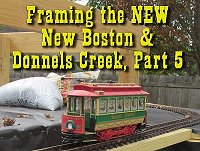 Proceed to "Framing the NEW New Boston and Donnels Creek RR, Part. 5" -
Spreading the vinyl underlayment on the top layer. Prepping used Aristo track for (hopefully) many more years of service. Laying the first loop of track, and testing conductivity with a Bachmann streetcar. Proceed to "Framing the NEW New Boston and Donnels Creek RR, Part. 5" -
Spreading the vinyl underlayment on the top layer. Prepping used Aristo track for (hopefully) many more years of service. Laying the first loop of track, and testing conductivity with a Bachmann streetcar.
Click on the photo to see our status as of October, 10, 2017
 Return to "Framing the NEW New Boston and Donnels Creek RR, Part 3" -
Getting the frame finished on the top layer, ordering other things I'd need eventually, deciding on materials for the decking on the top layer (at least). Return to "Framing the NEW New Boston and Donnels Creek RR, Part 3" -
Getting the frame finished on the top layer, ordering other things I'd need eventually, deciding on materials for the decking on the top layer (at least).
Click on the photo to see our status as of September 17, 2017
 Return to "Framing the NEW New Boston and Donnels Creek RR, Part 2" -
Once I had the overall frame relatively solid, I hooked up the underground power lines to two GFI plugs that should be in easy reach once everything is finished. I also decided to frame out the top railroad layer while I could still access the center of the railroad easily. Because I was running out of vertical space, I reconfigured that layer. Then after I got the "core" pieces on, I changed my plan again. But the whole thing is getting easier and easier to visualize, and is getting closer to complete with every board I cut and fasten on. Return to "Framing the NEW New Boston and Donnels Creek RR, Part 2" -
Once I had the overall frame relatively solid, I hooked up the underground power lines to two GFI plugs that should be in easy reach once everything is finished. I also decided to frame out the top railroad layer while I could still access the center of the railroad easily. Because I was running out of vertical space, I reconfigured that layer. Then after I got the "core" pieces on, I changed my plan again. But the whole thing is getting easier and easier to visualize, and is getting closer to complete with every board I cut and fasten on.
Click on the photo to see our status as of September 7, 2017
 Return to "Framing the NEW New Boston and Donnels Creek RR, Part 1" -
Once I started dropping posts in the holes and screwing things together, I didn't want to stop before I had the basic frame built (for one thing, the wood warps less once it's fastened in place). Now the folks driving down the street past our house (we're on a corner lot) probably wonder if I'm building an elaborate chicken coop, but that's fine with me. I still need to make a few more lumber runs and do a lot more cutting and sawing, but having the basic frame in place should make the next bits a lot easier. Return to "Framing the NEW New Boston and Donnels Creek RR, Part 1" -
Once I started dropping posts in the holes and screwing things together, I didn't want to stop before I had the basic frame built (for one thing, the wood warps less once it's fastened in place). Now the folks driving down the street past our house (we're on a corner lot) probably wonder if I'm building an elaborate chicken coop, but that's fine with me. I still need to make a few more lumber runs and do a lot more cutting and sawing, but having the basic frame in place should make the next bits a lot easier.
Click on the photo to see our status as of August 10, 2017
 Return to "Breaking Ground on the NEW New Boston and Donnels Creek" -
Okay, in case you wondered if we'd ever get started on the thing, we broke ground in July, using a manual post-hole digger. Well two manual post-hole diggers. But by the end of this article, we're ready for the posts to start going in. Return to "Breaking Ground on the NEW New Boston and Donnels Creek" -
Okay, in case you wondered if we'd ever get started on the thing, we broke ground in July, using a manual post-hole digger. Well two manual post-hole diggers. But by the end of this article, we're ready for the posts to start going in.
Click on the photo to see our status as of the end of July, 2017
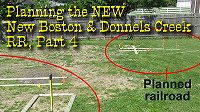 Return to "Planning the NEW New Boston and Donnels Creek, Part 4" -
Well, the rented post-hole digger fell through, so we dug our vegetable garden with a manual post-hole digger (the scissors kind). In addition, I stake out where the railroad was going to be. Twice. And tweaked the plans again. Sorry about the redo's, but sometimes just walking around the yard trying to visualize things makes me reconsider something that seemed "settled" only a few days before. Return to "Planning the NEW New Boston and Donnels Creek, Part 4" -
Well, the rented post-hole digger fell through, so we dug our vegetable garden with a manual post-hole digger (the scissors kind). In addition, I stake out where the railroad was going to be. Twice. And tweaked the plans again. Sorry about the redo's, but sometimes just walking around the yard trying to visualize things makes me reconsider something that seemed "settled" only a few days before.
Click on the photo to see what we were considering as of late May, 2017
 Return to "Planning the NEW New Boston and Donnels Creek, Part 3" -
We have still not broken ground. In part because we plan to rent a post-hole digger and dig the post holes for our raised vegetable garden and the first phase of the garden railroad at the same time, and we don't have enough lumber on hand yet. (If we didn't break it down into multiple trips, we'd be blowing out the shocks on our minivan.) In the meantime, we used a line level to see if the slope of the back yard was as bad as we thought it was (it's worse), and we did other site preparation, including planting a whole bunch of spruce tree seedlings to eventually give us some privacy in our side and back yard. Plus, I'm still wavering a little on the "where-to-start-first" issue. Return to "Planning the NEW New Boston and Donnels Creek, Part 3" -
We have still not broken ground. In part because we plan to rent a post-hole digger and dig the post holes for our raised vegetable garden and the first phase of the garden railroad at the same time, and we don't have enough lumber on hand yet. (If we didn't break it down into multiple trips, we'd be blowing out the shocks on our minivan.) In the meantime, we used a line level to see if the slope of the back yard was as bad as we thought it was (it's worse), and we did other site preparation, including planting a whole bunch of spruce tree seedlings to eventually give us some privacy in our side and back yard. Plus, I'm still wavering a little on the "where-to-start-first" issue.
Click on the photo to see what we were considering as of late April, 2017
 Return to "Planning the NEW New Boston and Donnels Creek, Part 2" -
More plans. We've moved on from the 2"x6" roadbed-on-posts to a sort of "train-table-outside" plan. Our goals include low-maintenance, high interest, and high reliability. We're also trying to get around having a thousand dollars' worth of dirt hauled into the back yard. If you want to get some idea of what our planning process looks like, reading these through in sequence may help. Or it may drive you crazy. Return to "Planning the NEW New Boston and Donnels Creek, Part 2" -
More plans. We've moved on from the 2"x6" roadbed-on-posts to a sort of "train-table-outside" plan. Our goals include low-maintenance, high interest, and high reliability. We're also trying to get around having a thousand dollars' worth of dirt hauled into the back yard. If you want to get some idea of what our planning process looks like, reading these through in sequence may help. Or it may drive you crazy.
Click on the photo to see what we were considering in early April, 2017
 Return to "Planning the NEW New Boston and Donnels Creek, Part 1" -
If you're subscribed to our newsletter, you know that we moved just after Thanksgiving in 2016, leaving behind most of the track, a few of the bird feeders, and one Bachmann train set for the new owners. We also left behind a high-maintenance garden that we do not intend to replicate at the new place. This is the first chapter of a new chapter in our lives, which we hope will include a lot of "lessons learned." But first, some serious landscaping had to take place. Return to "Planning the NEW New Boston and Donnels Creek, Part 1" -
If you're subscribed to our newsletter, you know that we moved just after Thanksgiving in 2016, leaving behind most of the track, a few of the bird feeders, and one Bachmann train set for the new owners. We also left behind a high-maintenance garden that we do not intend to replicate at the new place. This is the first chapter of a new chapter in our lives, which we hope will include a lot of "lessons learned." But first, some serious landscaping had to take place.
Click on the photo to see what we were considering in March, 2017
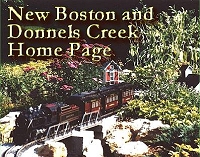 Return to the New Boston and Donnels Creek RR Page - This is the page describing Paul Race's progress and frequent rework on his own garden railroad, started on a shoe-string budget in 1998, later expanded, and later refurbished several times as issues arose. Issues that Paul hopes to avoid by building the next iteration above ground. Return to the New Boston and Donnels Creek RR Page - This is the page describing Paul Race's progress and frequent rework on his own garden railroad, started on a shoe-string budget in 1998, later expanded, and later refurbished several times as issues arose. Issues that Paul hopes to avoid by building the next iteration above ground.
 Return to Family Garden Trains' Home Page - The home page with links to all the other stuff, including design guidelines, construction techiques, structure tips, free graphics, and more. Return to Family Garden Trains' Home Page - The home page with links to all the other stuff, including design guidelines, construction techiques, structure tips, free graphics, and more.
|

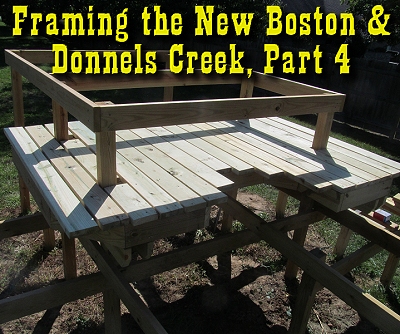























 The graphic to the right shows the framing completed and ready for decking. I know, that it wouldn't have taken most people months to get to this point, but I am trying something entirely new for me, and I didn't want to accidentally create problems that would cause maintenance issues or some such later.
The graphic to the right shows the framing completed and ready for decking. I know, that it wouldn't have taken most people months to get to this point, but I am trying something entirely new for me, and I didn't want to accidentally create problems that would cause maintenance issues or some such later.















































